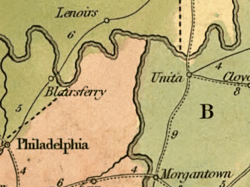Blair's Ferry Storehouse
Originally built as a storehouse for the burgeoning riverboat trade in the community of Blair's Ferry in the 1830s, the structure was eventually renovated and used for a variety of functions throughout the 19th and 20th centuries.
In 1819, taking advantage of a provision in the Calhoun Treaty, the Cherokee leader Pathkiller claimed a 640-acre (260 ha) reservation of land that included Blair's Ferry.
[3][4] The Blair's Ferry Storehouse was constructed shortly after this legal victory to take advantage of the growing river trade.
The company intended to connect Dalton with Knoxville, but struggled to raise funding to build a bridge across the Tennessee River, and thus Blairsville became the railroad's temporary northern terminus.
With the help of railroad planners, Blairsville expanded, and was renamed "Loudon" after the nearby colonial Fort Loudoun.
In the years 1852 to 1855 (when the bridge was completed), Loudon experienced a boom period, with farmers arriving from around the region to ship their crops to the south.
[5] After the U.S. Civil War, the Blair's Ferry Storehouse came into the possession of a local merchant named John West, who continued to use it as a general store.
[3] The Blair's Ferry Storehouse is a Federal-style two-story building with a stepped brick facade and gable roof.


